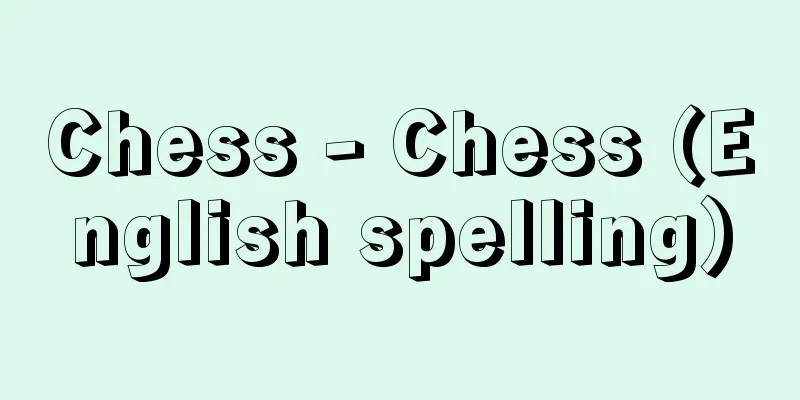Chess - Chess (English spelling)

|
A type of board game played by two players. It is also called Western Shogi. Chaturanga, which originated in ancient India, was introduced to Europe and gradually changed, and the current international rules were established in the 15th century. The word chess comes from the Persian word shah (meaning king). It is called Schach in German, échecs in French, and shahmatï in Russian. The International Chess Federation (FIDE, headquartered in Lausanne, Switzerland) was founded in 1924 and currently has 157 member countries, including Japan (1998). It holds an annual championship tournament (every two years until 1998) and the Chess Olympiad every two years. The International Correspondence Chess Federation (ICCF, headquartered in Germany), with approximately 110 member countries, including Japan, hosts events such as the International Postal Chess Olympiad. Traditionally, it was a game for royalty and aristocrats, but today it has become a popular intellectual sport with hundreds of millions of participants. Computer chess also began to develop around the 1970s, and in 1997 IBM's dedicated chess machine, Deep Blue, defeated one of the world champions, Garry Kasparov of Russia, making headlines around the world. [Higashi Kohei] World overviewSeven of the 13 world chess champions to date have been from the former Soviet Union, and the former Soviet bloc countries have also had an overwhelming lead in the international Chess Olympics. Eastern European countries follow, and there are also strong players scattered across Northern Europe, North America, South America, and Western Europe. Old countries in Southeast Asia and the Arab world still have their own versions of chess that are unique to their region, each with its own set of rules. Xiangqi, which is popular in China, is a unique form that is different from both chess and Japanese shogi, but the objective of checkmating the king is the same in both. [Higashi Kohei] Overview of JapanThere is no clear evidence as to when chess was introduced to Japan, but it is believed to have been during the Edo period. In the Meiji era, there are records of it being played among some of the upper classes, including shogi master Ono Gohei. It became popular after World War II, when the Japan Chess Federation was founded, led by shogi 9-dan player Sakaguchi Nobuhiko. In 1968 (Showa 43), the Japan Chess Association (JCA) was formed, and Japan joined the International Chess Federation, marking the beginning of its full-scale development by sending representative players to the World Chess Championship for the first time. [Higashi Kohei] Equipment and MethodThe board is a square with no size limit, with a checkerboard pattern of light and dark shades (commonly known as black and white), and has 64 squares in an 8x8 arrangement. Players place the pieces so that the white square is in the front right corner. The pieces are three-dimensional human shapes made of wood, ivory, stone, etc., and there are 16 black and 16 black pieces, for a total of 32 pieces. The pieces are arranged in the squares as shown in , and the white piece goes first, moving alternately one move at a time. The first player to capture (checkmate) the opponent's king wins. [Higashi Kohei] How to move the piecesThe king can move one step at a time to eight surrounding positions (right of (1)). The queen can move any number of times vertically, horizontally, or diagonally (left of (1)). The rook can move any number of times vertically or horizontally (right of (2)), and the bishop can move any number of times diagonally (right of (3)), but along with the queen and rook, they cannot jump over other pieces. The knight can move in eight directions like the knight in shogi (left of (2)), and can jump over pieces. In principle, the pawn can only move one step forward, but it can also move two steps forward (left of (3)) only when it leaves its original position. In principle, the performance of the pieces does not change, but only the pawn can change (promote) into any piece other than the king as soon as it reaches the first row of the opponent's camp. Usually, it becomes the most powerful queen, but in this case, it does not matter if the original queen is still on the board, as long as it is marked as a new queen. [Higashi Kohei] How to capture a pieceIf there is an opponent's piece at the destination of the piece you are about to move, move it to that position and remove the opponent's piece from the board. The removed piece cannot be used until the end of the game (it can only be reused as a replacement piece in case a pawn is promoted). However, the way pawns move and are captured is different (right side of ), and when capturing them, they move one step diagonally forward. Therefore, if there is another piece (either friend or foe) in the square immediately in front of the pawn, that pawn cannot move unless an opponent's piece is diagonally forward. [Higashi Kohei] Check and CheckmateThe next situation in which the opponent's king can be taken (the two left examples in ) is called a check. A player who is in check must defend to prevent the king from being taken. If this is not possible, it is checkmate, and the player loses (the top two examples in ). If the player accidentally fails to remove the check, the opponent cannot "take" the king, and the game returns to the original position, allowing the player to defend against the check. [Higashi Kohei] Foul play and its handlingIf a player touches a teammate's piece, he or she is obligated to move that piece if it is their turn. If a player touches an opponent's piece, they must also take that piece. However, if it is impossible to move, no penalty is applied. If the initial placement of the pieces is incorrect, or if a piece is moved in an illegal manner during the game and cannot be restored to its original state, the game is invalid. [Higashi Kohei] Special rules and other[1] Castling (entering a castle): When there are no pieces between the king and either of the rooks, in one move you can "move the king two spaces to the right (or left) and move the rook inward" ( , bottom). However, this move is only allowed if (1) neither the king nor the rook have moved yet, (2) they are not currently in check, and (3) there is no way for an opponent's piece to get through to the king's path. [2] Capturing en passant When one pawn (white) advances to the fifth row and the other pawn (black) advances two steps to line up next to it (upper left of ), the white pawn is allowed to advance diagonally and capture the black pawn "in the same manner as when the opponent's pawn advances one step." If the pawn does not capture the pawn immediately after lining up, the right is lost, but the capture is optional. [3] Draw: The game is a draw and counts as a 0.5 win in the following cases: (1) when both players are left with only a king, (2) when neither player has enough troops to checkmate, (3) when the exact same position appears three times in one game and one of the players requests a draw (a thousand-day stalemate), (4) when both players agree on the outcome and accept the draw, or (5) when neither player has captured a piece or moved a pawn for 50 moves (the 50-move rule). In chess, one move is made by each of the white and black players. In official matches, a chess clock (a special clock) is used, and if a certain number of moves are not completed within a certain time, the player will lose due to time running out. [4] Stalemate: When one player is not currently in check but has no next move to make, meaning that if he makes a move, his king will be taken, this is called a stalemate and the game ends in a draw (see below in for an example). [Higashi Kohei] Chess hierarchyAfter World Champion, there are the titles of Grandmaster and International Master, which are officially recognized by the International Chess Federation based on competitive performance. Next are the ranks of National Master and Expert, which are recognized by each country's chess organization, but the levels and names vary from country to country. [Higashi Kohei] "Chess" by Sakaguchi Masahiko (1961, Seibundo Shinkosha)" ▽ "Higashi Kohei's Introduction to Chess" by Azuma Kohei (1975, Kawade Shobo Shinsha)" ▽ "Chess Openings and Fighting Techniques" by Arita Kenji (1980, Kawade Shobo Shinsha)" ▽ "Jacques Pineau's Introduction to Dynamic Chess" by Jacques Pineau (1995, Sankaido)" ▽ "Illustrated Chess: Winning Moves" by Watai Miyoko (1997, Nitto Shoin) ©Shogakukan "> How to arrange chess pieces, their types and names (Figure A) ©Shogakukan "> How to move chess pieces (Figure B) ©Shogakukan "> How to capture and check chess pieces (Figure C) ©Shogakukan "> Checkmate and Castling (Figure D) ©Shogakukan "> En passant and steermate (Fig. E) Source: Shogakukan Encyclopedia Nipponica About Encyclopedia Nipponica Information | Legend |
|
2人で行う盤上競技の一種。西洋将棋ともいう。古代インドに発祥したチャチュランガchaturangaがヨーロッパに伝えられ、徐々に変形し、15世紀に現行国際ルールが確立された。チェスの語源はペルシア語のシャー(王の意)。ドイツ語でシャッハSchach、フランス語でエシェックéchecs、ロシア語でシャーフマトゥイшахматы/shahmatïという。 国際チェス連盟(FIDE(フィデ)、本部はスイスのローザンヌ)は1924年に創立され、現在日本も含め加盟157か国(1998)。年1回のチャンピオン決定戦(1998年までは2年ごと)と、2年ごとのチェス・オリンピックが行われる。国際通信チェス連盟(ICCF、本部ドイツ)は日本も含め加盟約110か国で、国対抗郵便チェス・オリンピアードなどを主催する。古来、王侯貴族の遊びであったが、現在では数億の競技人口をもつ頭脳スポーツとして普及している。 また、コンピュータ・チェスが1970年代ごろから発達し、1997年にはIBM社のチェス専用マシン「ディープ・ブルー」が世界チャンピオンの一人であるロシアのガルリ・カスパロフを破って世界中の話題となった。 [東 公平] 世界の概況チェスの世界チャンピオンは歴代13人中7人が旧ソ連人であり、国対抗のチェス・オリンピックでも旧ソ連圏諸国が圧倒的にリードしていた。東ヨーロッパ諸国がこれに次ぎ、北ヨーロッパ、北アメリカ、南アメリカ、西ヨーロッパにも強豪が点在する。東南アジア、アラブなどの古い国には、その地域固有のチェスが残っており、ルールがそれぞれ異なっている。なお中国で流行している象棋(シャンチー)は、チェスとも日本将棋とも違う独特の形態だが、王を詰めるという目的だけは、いずれも共通している。 [東 公平] 日本の概況チェスの日本への伝来の時期については明確な証拠はないが、江戸時代と推定される。明治に入ると将棋の小野五平名人ら、一部の上流階級の間で行われた記録がある。流行をみせたのは第二次世界大戦後で、そのころは坂口允彦(のぶひこ)将棋九段を中心とした日本チェス連盟があった。1968年(昭和43)には日本チェス協会(JCA)が結成され、国際チェス連盟に加盟、初めて世界選手権大会に代表選手を送るなど本格的発展の緒についた。 [東 公平] 用具と競技方法盤は正方形で大きさに制限はなく、濃淡(黒白と通称する)の市松(いちまつ)模様で、8×8の64枡(ます)である。右手前に白枡がくるように置く。駒(こま)は木、象牙(ぞうげ)、石などでつくられた立体の人形状で、白黒各16、計32個。のように枡目の中に並べ、白が先手で1手ずつ交互に駒を動かし、先に相手のキングを捕らえた(詰ませた)者の勝ちである。 [東 公平] 駒の動かし方キングは周囲8か所へ1歩ずつ動ける((1)の右)。クイーンは縦・横・斜めにいくつでも動ける((1)の左)。ルークは縦・横にいくつでも((2)の右)、ビショップは斜めにいくつでも動ける((3)の右)が、クイーン、ルークとともに、ほかの駒を飛び越えてはならない。ナイトは将棋の桂馬(けいま)のように八方に動き((2)の左)、駒を飛び越してもよい。ポーンは原則として1歩前進だけだが、初めに並べられた位置から出るときに限り2歩前進((3)の左)も許される。駒の性能は原則として不変だが、ポーンに限り相手陣の1段目に達すると同時にキング以外の望みの駒に変化する(成る)ことができる。通常、もっとも強力なクイーンに成るが、この際、盤上に本来のクイーンがあってもかまわず、新たなクイーンであることを目印で示せばよい。 [東 公平] 駒の取り方動かそうとする駒の行き先に相手の駒があれば、その位置まで進めて、相手の駒を盤から取り除く。取り除かれた駒は終わりまで使用できない(ポーンが成った場合の代替駒として再使用するだけ)。ただし、ポーンに限り、動き方と取り方が異なり(の右)、取るときは斜め前に1歩進んで取る。したがって、ポーンの直前の枡に他の駒(敵味方を問わず)があると、そのポーンは、斜め前に相手の駒がこない限り動くことができない。 [東 公平] チェックとチェックメイト次に相手のキングが取れる状態(の左2例)をチェックcheckという。チェックをかけられた競技者は、かならず防御を施してキングを取られないようにする。それが不可能であるときはチェックメイトcheckmate(詰み)で、負けである(の上2例)。もし誤ってチェックの解消を怠っても、相手方はキングを「取る」ことはできず、元の局面に戻して、チェックの防御をすることを許す。 [東 公平] 反則とその処置味方の駒に手を触れた場合、その人の番であればその駒を動かす義務が生じる。また相手の駒に触れた場合も、その駒を取らなくてはならない。ただし、上が不可能であればなんら罰則は適用されない。最初の駒の配置が誤っていたり、途中でルールに反した駒の動きがあり、しかも元の状態に復原できないときは、そのゲームは無効である。 [東 公平] 特殊ルール・その他〔1〕キャスリングcastling(入城) キングと、いずれか一方のルークとの間に駒がなくなったとき、1手で「キングを2間右(または左)へ動かし、ルークをその内側へ動かす」こと(の下)ができる。ただし、この手は、(1)キングもルークもまだ動いたことがなく、(2)現在チェックをかけられておらず、(3)キングの通路に相手駒のきき道が通っていないときに限り許される。 〔2〕アンパッサンcapturing en passant(通過取り) 一方のポーン(白)が5段目まで前進し、他方のポーン(黒)が2歩前進して横に並んだとき(の上左)、「相手のポーンが1歩前進したときと同じ形で」白ポーンは斜めに前進して、黒ポーンを取ることが許される。これは並んだ直後に取らなければ権利を失うが、取るのは任意である。 〔3〕ドローdraw(引き分け) 次の場合そのゲームはドローになり、0.5勝と計算する。(1)互いにキングだけになったとき、(2)互いにチェックメイトに十分な兵力がなくなったとき、(3)まったく同じ局面が1局に三度現れ、対局者の一方がドローを申し立てたとき(千日手(せんにちて))、(4)双方の見通しが一致して引き分けを認め合ったとき、(5)50手の間、互いに駒が取られず、ポーンも動かなかったとき(50手ルール)。 なお、チェスでは白・黒各1回の動きを1手という。公式戦ではチェス・クロック(特別な時計)を使用し、一定の手数を一定の時間内に指し終わらなければ時間切れの負けになる。 〔4〕ステールメイトstalemate(手詰まり) 一方が現在チェックをかけられていないにもかかわらず、次に指す手がない、すなわち指せばキングを取られる状態にあるときはステールメイトと称して引き分けになる(の下はその例)。 [東 公平] チェスの階級世界チャンピオンに次いでグランドマスター、インターナショナルマスターの称号があり、競技成績を考課して国際チェス連盟が公認する。その次に各国のチェス団体が認可するナショナルマスター、エキスパートなどの階級があるが、国により水準も名称もまちまちである。 [東 公平] 『坂口允彦著『チェス』(1961・誠文堂新光社)』▽『東公平著『ヒガシコウヘイのチェス入門』(1975・河出書房新社)』▽『有田謙二著『チェスの定跡と戦い方』(1980・河出書房新社)』▽『ジャック・ピノー著『ジャック・ピノーのダイナミックチェス入門』(1995・山海堂)』▽『渡井美代子著『図解チェス―必勝の手筋』(1997・日東書院)』 ©Shogakukan"> チェスの駒の並べ方、種類と名称〔図A〕 ©Shogakukan"> チェスの駒の動かし方〔図B〕 ©Shogakukan"> チェスの駒の取り方とチェック〔図C〕 ©Shogakukan"> チェックメイトとキャスリング〔図D〕 ©Shogakukan"> アンパッサンとステールメイト〔図E〕 出典 小学館 日本大百科全書(ニッポニカ)日本大百科全書(ニッポニカ)について 情報 | 凡例 |
Recommend
Aztecs
…The Aztecs were people of Aztlan, their legendar...
Svayaṃbhū (English spelling)
Brahma is said to have emerged from the lotus (wo...
alpine garden
…Originally from Europe, it was invented to plant...
Yomiuri dispute - Yomiuri dispute
A dispute that occurred at the Yomiuri Shimbun aft...
Old Sosonomori - Oisonomori
<br /> A forest in Higashi-Oiso, Azuchi-cho,...
Hard boiled - Hard boiled
A realist style that appeared in American literat...
Sveinsson, A.
...However, in terms of visual arts, not many not...
Takayuki Sasaki
Born: November 12, 1830. Tosa, Seto [Died] March 2...
Chiharu Imaizumi
Born: December 17, 1775, Saga [Died] September 19,...
Shace's Rebellion - Shace's Rebellion
A farmer uprising that took place in western Massa...
Postscript - Great Explosion
A Chinese literary style. It refers to the "...
Kikai Caldera
Iwo Jima (Kikaigashima), a caldera stretching fro...
Gāhadavāla (English spelling)
…They had a strong sense of pride as warriors, an...
VIN - Vehicle I/N
Vehicle identification number: A vehicle registrat...
Curvature circle - curvature circle
〘noun〙 A circle that shows the degree of curvature...









